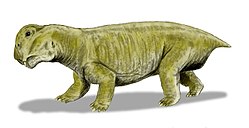Palaeobiota
Synapsids
| Genus | Species | Location | Stratigraphic position | Material | Notes | Images |
|---|---|---|---|---|---|---|
| Lystrosaurus | L. murrayi | A lystrosaurid dicynodont. Synonyms include L. orientalis and L. rajurkari. |  | |||
| L. cf. curvatus | A lystrosaurid dicynodont. | |||||
| L. cf. declivis | A lystrosaurid dicynodont. | |||||
| Panchetocynodon | P. damodarensis | A cynodont of uncertain affinity. | ||||
| Thrinaxodon | T. bengalensis | A thrinaxodontid cynodont. | Considered a nomen nudum. The specimen is lost. | |||
Amphibians
| Genus | Species | Location | Stratigraphic position | Material | Notes | Images |
|---|---|---|---|---|---|---|
| ?Benthosuchidae indet. | ||||||
| Capulomala | C. panchetensis | A plagiosaurid temnospondyl. | ||||
| Gonioglyptus | G. fragilis | A trematosaurid temnospondyl. | ||||
| G. longirostris | ||||||
| Indobrachyops | I. panchetensis | A rhytidosteid temnospondyl. |  | |||
| Indolyrocephalus | I. huxleyi | A trematosaurid. | ||||
| Lydekkerina | L. sp. | A lydekkerinid temnospondyl. |  | |||
| Pachygonia | P. incurvata | Possibly a brachyopid temnospondyl. | ||||
| Manubrantlia | M. khaki | A lapillopsid temnospondyl |  | |||
| Tupilakosaurus | T. sp | A tupilakosaurid temnospondyl. |  |
Reptiles
| Genus | Species | Location | Stratigraphic position | Material | Notes | Images |
|---|---|---|---|---|---|---|
| Samsarasuchus | S. pamelae | A proterosuchid archosauriform. | ||||
| ?" Teratosaurus " | T. bengalensis | A dubious archosauriform represented by a single tooth, formerly considered a rauisuchian but most likely a proterosuchid. [3] | ||||
| Ankistrodon | A. indicus | Dubious proterosuchid. | ||||
| Neodiapsida indet. | A non-archosauromorph diapsid, known from an ilium. [4] | |||||
Fish
| Genus | Species | Location | Stratigraphic position | Material | Notes | Images |
|---|---|---|---|---|---|---|
| Acrolepidae indet. | An acrolepid fish. | |||||
| Perleididae indet. | A perleidid fish. | |||||
| Chondrichthyes indet. | A cartilaginous fish. | |||||
| Ceratodontidae indet. | A ceratodontid lungfish. |